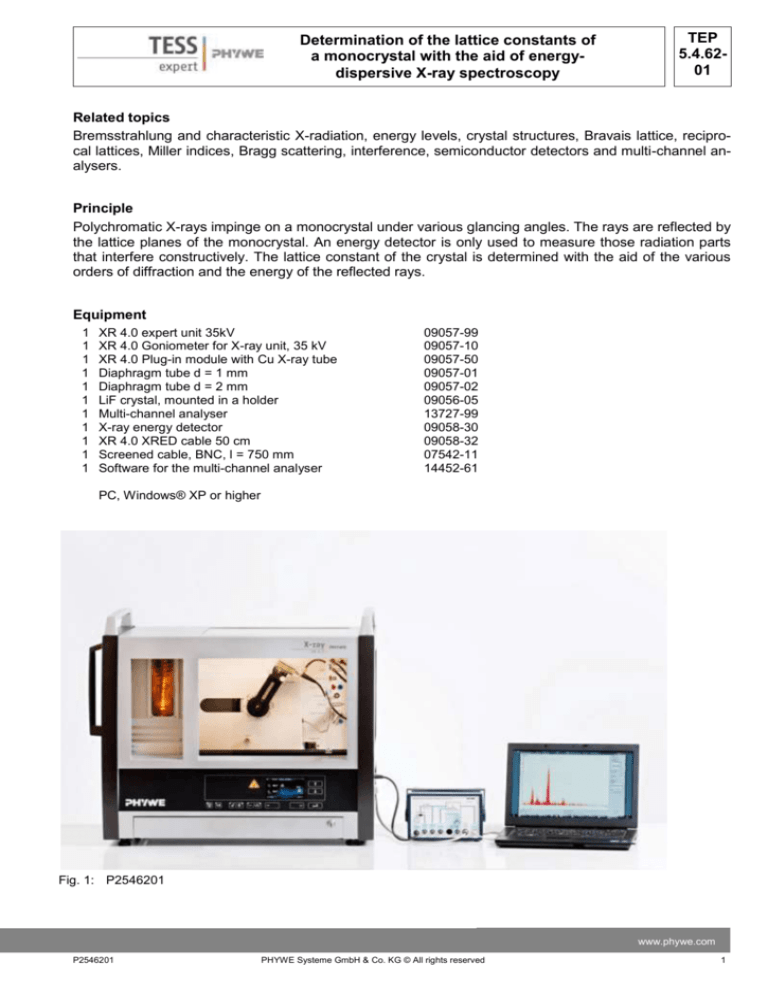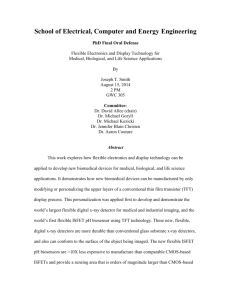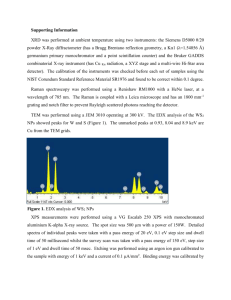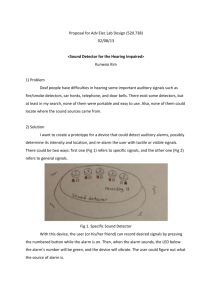
Determination of the lattice constants of
a monocrystal with the aid of energydispersive X-ray spectroscopy
TEP
5.4.6201
Related topics
Bremsstrahlung and characteristic X-radiation, energy levels, crystal structures, Bravais lattice, reciprocal lattices, Miller indices, Bragg scattering, interference, semiconductor detectors and multi-channel analysers.
Principle
Polychromatic X-rays impinge on a monocrystal under various glancing angles. The rays are reflected by
the lattice planes of the monocrystal. An energy detector is only used to measure those radiation parts
that interfere constructively. The lattice constant of the crystal is determined with the aid of the various
orders of diffraction and the energy of the reflected rays.
Equipment
1
1
1
1
1
1
1
1
1
1
1
XR 4.0 expert unit 35kV
XR 4.0 Goniometer for X-ray unit, 35 kV
XR 4.0 Plug-in module with Cu X-ray tube
Diaphragm tube d = 1 mm
Diaphragm tube d = 2 mm
LiF crystal, mounted in a holder
Multi-channel analyser
X-ray energy detector
XR 4.0 XRED cable 50 cm
Screened cable, BNC, l = 750 mm
Software for the multi-channel analyser
09057-99
09057-10
09057-50
09057-01
09057-02
09056-05
13727-99
09058-30
09058-32
07542-11
14452-61
PC, Windows® XP or higher
Fig. 1: P2546201
www.phywe.com
P2546201
PHYWE Systeme GmbH & Co. KG © All rights reserved
1
TEP
5.4.6201
Determination of the lattice constants of
a monocrystal with the aid of energydispersive X-ray spectroscopy
Tasks
1. Determine the energy of the X-rays that are reflected at the lattice planes of the LiF-crystal for
various glancing angles or diffraction orders.
2. Calculate the lattice constant of the LiF-crystal
based on the glancing angles and associated
energy values.
Set-up and procedure
Set-up (Fig. 1)
- Screw the adapter ring onto the inlet tube of the
energy detector.
- Connect the signal and supply cables to the
corresponding ports of the detector with the aid
of the right-angle plugs.
- Connect the signal and supply cables from the
MCA to the appropriate connections in the exFig. 2: Connections in the experimentation area
periment chamber of the X-ray unit (signal cable: red, supply cable: green (see Fig. 2)).
- Connect the external ports for the X RED of the
x-ray unit (signal cable red, supply cable green,
see Fig. 3) to the multi-channel analyse (MCA).
Connect the signal cable via a screened BNCcable to the “Input” port of the MCA and the
supply cable to the “X-Ray Energy Det.” port of
the MCA.
- Secure the energy detector in the holder of the Fig. 3: Connection at the external panel of the XR 4.0 Xray expert unit to the MCA
swivel arm of the goniometer. Lay the two cables with sufficient length so that the goniometer can be swivelled freely over the entire swivelling range.
Left position of
- Connect the multi-channel analyser and comthe goniometer
puter with the aid of the USB cable.
- Insert the tube with the 2-mm-aperture.
- Bring the goniometer block and the detector to
their respective end positions on the left. Bring
the detector to the 90° position in the 2:1 couX-ray energy
pling mode (Fig. 4).
detector
Mounted crystal
Calibration of the multi-channel analyser
(if there is no other already existing calibration that
can be used)
- Bring the goniometer block and the detector to Fig. 4: Set-up at the goniometer
their respective end positions on the right.
- Insert the tube with the 1mm-aperture into the
exit tube of the X-ray tube.
- With the X-ray unit switched on and the door locked, bring the detector to the 0° position. Then, shift
the detector by some tenths degree out of the zero position in order to reduce the total rate.
- Operating data of the tungsten X-ray tube: Select an anode voltage UA = 25 kV and an anode current
2
PHYWE Systeme GmbH & Co. KG © All rights reserved
P2546201
Determination of the lattice constants of
a monocrystal with the aid of energydispersive X-ray spectroscopy
TEP
5.4.6201
IA = 0.02 mA and confirm these values by
-
-
-
pressing the “Enter” button.
Switch on the X-radiation
In the MEASURE program, select “Multi channel analyser” under “Gauge”. Then, select “Settings and calibration”. After the “Calibrate” button has been clicked, a spectrum can be
measured. The counting rate should be < 300
c/s. Energy calibration settings: - 2-point calibration, - Unit = keV, Gain = 2 – Set the offset
so that low-energy noise signals will be suppressed (usually a few per cent are sufficient),
Fig. 5: calibration of the multi-channel analyser
See Fig 5.
Measuring time: 5 minutes. Use the timer of the
X-ray unit.
Make the two coloured calibration lines congruent with the line centres of the two characteristic X-ray
lines. The corresponding energy values (see e.g. P2544701) E(L3M5/L3M4) = 8,39keV and E(L2N4) =
9,69 keV are entered into the corresponding fields, depending on the colour. (Note: Since a separation of the lines L3M5 and L3M4 Lines is not possible, the mean value of both lines is entered as the
energy of the line).
Name and save the calibration.
Measurement of spectra with different orders of diffraction
- The goniometer block with the inserted LiF-crystal is at the left stop.
- The detector is at the front on the guide rods.
- Use the 1mm-diameter tube.
- Operate the crystal and the detector in the 2:1 mode.
- Use the parameters that were also used for the energy calibration.
- Record spectra at glancing angles from 10° – 42° in steps of 2°.
- Adjust an anode voltage Ua = 35 kV and an anode current ia so that the counting rates of the various
spectra ≈ 400 c/s.
Evaluation of the measurement curves
- In order to determine the line energy, switch from the bar display to the curve display. To do so, click
“Display options” and then “Interpolation and
straight lines”.
- Extend the relevant line section with the aid of
the zoom function
“.
- Then, select the curve section with
“, Open
the window “Function fitting
.“ Then, select
“Scaled normal distribution” (see Fig. 6).
- Find the line centroid of the normal distribution
with “Peak analysis
“ or determine it with the
function “Survey“ .
Fig. 6: Bragg reflex with a superimposed normal distriTheory and evaluation
bution
The X-rays that hit the monocrystal under the glanc-
www.phywe.com
P2546201
PHYWE Systeme GmbH & Co. KG © All rights reserved
3
TEP
5.4.6201
Determination of the lattice constants of
a monocrystal with the aid of energydispersive X-ray spectroscopy
ing angle ϑ (see Fig. 7) can only be observed in a reflection if the incident and reflected rays of the same
wavelength interfere constructively. This means,
however, that the path difference Δ of the rays must
be an integer multiple of the wavelength (in Fig. 3, Δ
is represented by the segments that are marked with
thick lines):
2d sin n
(1)
The condition in (1) is known as the Bragg condition.
(d = distance between the lattice planes, ϑ = glancing angle, λ = wavelength, and n = 1, 2, 3,...)
Fig. 7: Constructive interference during the reflexion on
lattice planes of crystals
If monoenergetic rays with a wavelength λ hit the
family of lattice planes of the monocrystal and if the
glancing angle is large (larger path difference Δ), a 2nd order diffraction can be observed in accordance
with (1) with n = 2.
If, however, polychromatic rays hit the crystal and if the glancing angle is fixed (fixed path difference Δ),
the reflected ray will have parts with the wavelengths λ, ½ λ, ⅓ λ ... in accordance with (1), since in this
case the path difference corresponds to λ , 2½ λ, 3⅓ λ (see Fig. 8).
This situation can only be proved with an energy detector, but not with a Geiger-Müller counter tube that
is usually operated in the triggering mode.
If one replaces the wavelength in (1) by the associated energy E = h · ν and c = λ · ν: lead to:
En n
hc
2d sin
(2)
h = 6,626 · 10-34 Js
Speed of light in vacuum c = 2,998 · 108 ms-1
Photon frequency ν
Planck's constant
With a fixed glancing angle ϑ equation (2) leads to:
E n k n und
En
n
E1
(3)
Task 1: Determine the energy of the X-rays that are reFig. 8: Expanded path difference Δ = ABC to show varflected at the lattice planes of the LiF-crystal for variious diffraction orders with n = 1 (λ), n = 2 (21/2
ous glancing angles or diffraction orders.
λ) and n = 3 (31/3 λ)
Figure 9 shows the Bragg reflexes for various glancing angles. If the glancing is increased (increase of
Δ), more Bragg reflexes can be measured due to the constructive interference. If Δ increases, their energy decreases, since the associated wavelengths become increasingly larger.
The intensity in the low-energy range of the primary ray is very low. In addition, the spectral parts of
larger wavelengths are absorbed to a higher extent by the glass bulb of the X-ray tube. Both of these become noticeable in the decrease of intensity of the reflex lines up to their disappearance (see the line
with n = 1 in Fig. 9d and 9c).
The weak line at E = 8 keV must be assigned to the Cu-Kα fluorescence radiation. When the monoener-
4
PHYWE Systeme GmbH & Co. KG © All rights reserved
P2546201
TEP
5.4.6201
Determination of the lattice constants of
a monocrystal with the aid of energydispersive X-ray spectroscopy
getic photons, which are reflected by the crystal, penetrate the detector housing, they may cause fluorescence radiation around the materials that are used in the detector assembly. This radiation is also
measured by the detector.
The table shows the evaluation of the spectra. Reflex lines with n = 5 are ignored due to their low intensity.Columns B-E show the energy values En of the various diffraction orders with different glancing angles
(column A) that were determined during the experiment. Columns F-I show the corresponding values
En/n, whose rounded mean values are given in column J.
ϑ = 10°
ϑ = 16°
n= 1
n= 1
n= 2
a)
b)
n= 2
n= 1
n= 2
ϑ = 24°
ϑ = 30°
n= 1
n= 3
n= 3
n= 4
c)
d)
n= 2
ϑ = 42°
n= 3
n= 4
n= 5
e)
Fig. 9: Bragg reflexes with an increasing order of diffraction and various glancing angles.
a: ϑ = 10°, b: ϑ = 16°, c: ϑ = 24°, d: ϑ = 30°, e: ϑ = 42°
In Fig. e, the reflex with n = 1 cannot be observed.
www.phywe.com
P2546201
PHYWE Systeme GmbH & Co. KG © All rights reserved
5
TEP
5.4.6201
Determination of the lattice constants of
a monocrystal with the aid of energydispersive X-ray spectroscopy
Task 2: Calculate the lattice constant of the LiF-crystal based on the glancing angles and associated energy values.
Column K shows the value for the interplanar spacing d that was calculated with the aid of (2).
For this (100)-oriented LiF-monocrystal, the following rounded value results:
d200 (LiF) = (201.2 ± 0.5) pm; Δd/d ≈ 0.3%; (literature value d200 = 201.4 pm).
Accordingly, the edge length of the cubic LiF-lattice d100 = 402.8 pm.
Table:
A
ϑ/°
Determination of the interplanar spacing d200 of LiF
B
n=1
C
n=2
D
n=3
E
n=4
E1 / keV E2 / keV E3 / keV E4 / keV
10
12
14
16
18
20
22
24
26
28
30
34
38
42
6
17,69
14,80
12,70
11,17
9,93
8,94
8,14
7,53
6,94
6,51
6,11
5,43
4,96
-
29,60
25,43
22,40
20,00
18,05
16,52
15,20
14,05
13,16
12,36
11,04
10,00
9,2
24,87
22,88
21,17
19,82
18,62
16,63
15,10
13,84
28,19
26,54
24,89
22,22
20,31
18,56
F
G
H
I
E1
1 /keV
17,69
14,80
12,70
11,17
9,93
8,94
8,14
7,53
6,94
6,51
6,11
5,43
4,96
-
E2
2 /keV
E3
3 /keV
E4
4 /keV
14,80
12,72
11,20
10,00
9,03
8,26
7,60
7,03
6,58
6,18
5,52
5,00
4,60
8,29
7,63
7,06
6,61
6,21
5,54
5,03
4,61
PHYWE Systeme GmbH & Co. KG © All rights reserved
7,05
6,64
6,22
5,56
5,01
4,64
J
Emittel/keV
K
d/pm
17,69
14,80
12,71
11,19
9,97
8,98
8,23
7,59
7,02
6,59
6,18
5,51
5,00
4,62
201,8
201,5
201,6
201,0
201,2
201,8
201,1
200,8
201,5
200,4
200,6
201,2
201,4
200,5
P2546201






